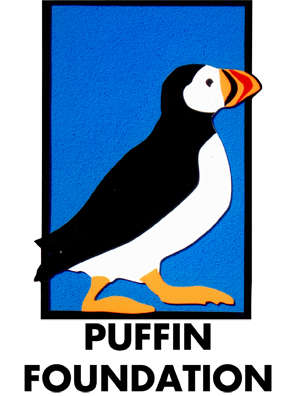 Thanks to the PUFFIN FOUNDATION for studio support in 2015.
The Puffin Foundation supports “projects that seek to enrich and inform the public on important subjects such as the environment, social justice, civil rights and other contemporary issues facing the country (and the planet), that some organizations might hesitate to fund.”]]>
Thanks to the PUFFIN FOUNDATION for studio support in 2015.
The Puffin Foundation supports “projects that seek to enrich and inform the public on important subjects such as the environment, social justice, civil rights and other contemporary issues facing the country (and the planet), that some organizations might hesitate to fund.”]]>
News
Leaving Home at Contemporary Applied Arts, London
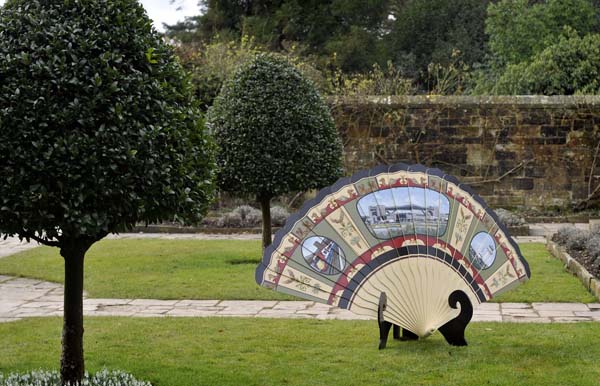 Leaving Home at Contemporary Applied Arts
89 Southwark Street, London
SE1 0HX
April 17 – May 31, 2015
Leaving Home at Contemporary Applied Arts
89 Southwark Street, London
SE1 0HX
April 17 – May 31, 2015
Unloaded at SPACE Gallery, Pittsburgh
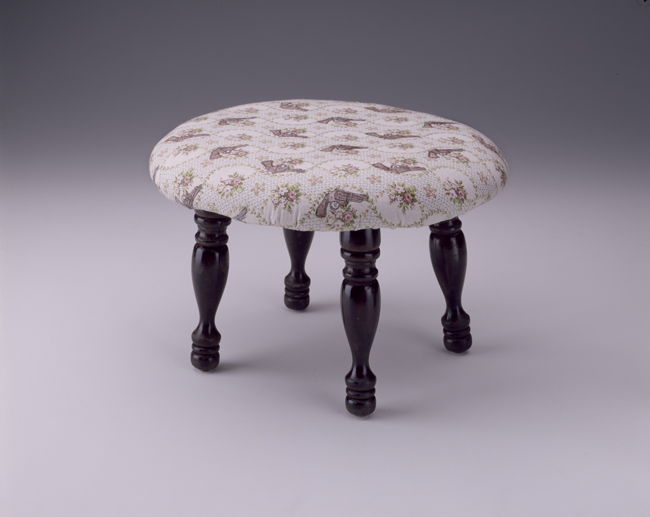 A multimedia group show that explores historical and social issues surrounding the availability, use, and impact of guns in our culture.
SPACE GALLERY, 812 Liberty Avenue, Pittsburgh, PA
February 13 – April 26, 2015
For more info: http://www.spacepittsburgh.org/portfolio-view/unloaded/
On view through April 26, 2015 with a closing reception during the April 24, 2015, Gallery Crawl.
UNLOADED includes the sculpture Cross for the Unforgiven by Mel Chin that configures eight AK-47s as a Maltese cross. Frozen in perpetual opposition, they are rendered dysfunctional, unable to exact a drop of blood. With ironic sentimentality, the assemblage Baby’s First Gun by Renee Stout commemorates a developmental milestone, while James Duesing’s Dog—a projected video of a hot dog holding a gun—offers a wry rendition of machismo. For the Homeland series, Nina Berman travelled the country photographing military weapons displays, SWAT team training, and drills designed to prepare for hypothetical terrorist attacks, in order to portray the evolution of the “American security state.” Resistance to the power of guns is embodied in Vanessa German’s sculptures, signs, and spoken word performances and in Jessica Fenlon’s ungun, a video composed of degrading glitched images of instruments of violence.
The exhibition features work by local and national artists, as well as artists working in China and Germany. Artists include Lauren Adams, Nina Berman, Joshua Bienko, Casey Li Brander, Anthony Cervino, Mel Chin, Cathy Colman, Dadpranks, James Duesing, Jessica Fenlon, Vanessa German, Jinshan, Andrew Ellis Johnson, Jennifer Nagle Myers, Adrian Piper, Don Porcella, Susanne Slavick, Renee Stout, and Stephanie Syjuco.
Curated by Susanne Slavick]]>
A multimedia group show that explores historical and social issues surrounding the availability, use, and impact of guns in our culture.
SPACE GALLERY, 812 Liberty Avenue, Pittsburgh, PA
February 13 – April 26, 2015
For more info: http://www.spacepittsburgh.org/portfolio-view/unloaded/
On view through April 26, 2015 with a closing reception during the April 24, 2015, Gallery Crawl.
UNLOADED includes the sculpture Cross for the Unforgiven by Mel Chin that configures eight AK-47s as a Maltese cross. Frozen in perpetual opposition, they are rendered dysfunctional, unable to exact a drop of blood. With ironic sentimentality, the assemblage Baby’s First Gun by Renee Stout commemorates a developmental milestone, while James Duesing’s Dog—a projected video of a hot dog holding a gun—offers a wry rendition of machismo. For the Homeland series, Nina Berman travelled the country photographing military weapons displays, SWAT team training, and drills designed to prepare for hypothetical terrorist attacks, in order to portray the evolution of the “American security state.” Resistance to the power of guns is embodied in Vanessa German’s sculptures, signs, and spoken word performances and in Jessica Fenlon’s ungun, a video composed of degrading glitched images of instruments of violence.
The exhibition features work by local and national artists, as well as artists working in China and Germany. Artists include Lauren Adams, Nina Berman, Joshua Bienko, Casey Li Brander, Anthony Cervino, Mel Chin, Cathy Colman, Dadpranks, James Duesing, Jessica Fenlon, Vanessa German, Jinshan, Andrew Ellis Johnson, Jennifer Nagle Myers, Adrian Piper, Don Porcella, Susanne Slavick, Renee Stout, and Stephanie Syjuco.
Curated by Susanne Slavick]]>
Animalia Agitatus at Edinboro University
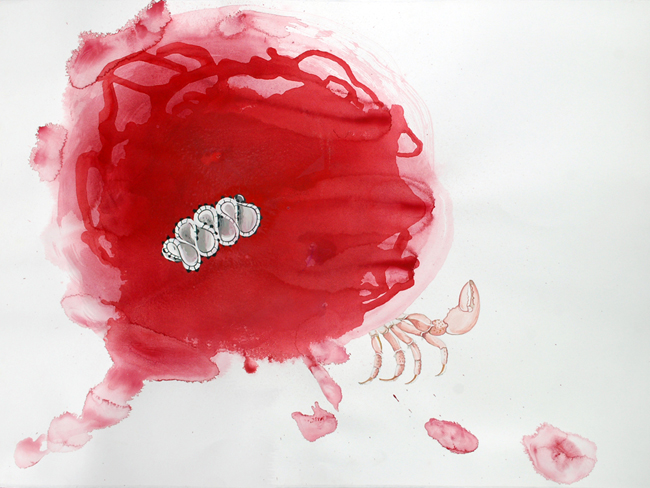 Animalia Agitatus, a group exhibition at Edinboro University, curated by Susanne Slavick
On exhibition in the month of February at Bruce Gallery in Pennsylvania.
Animalia Agitatus, a group exhibition at Edinboro University, curated by Susanne Slavick
On exhibition in the month of February at Bruce Gallery in Pennsylvania.
Flora and fauna is an expression that usually evokes images of the bucolic and benign. The artists in Animalia Agitatus have other ideas, veering from the pathetic to the provocative to the playful. Anthropomorphized or annihilated, modified or commodified, the fauna in Animalia Agitatus bear witness to the heights and depths of human experience.
Portrayed in an array of predicaments and pleasures, creatures cavort around calamity and potential captivity, enacting fantasies both farcical and ferocious. They strain toward the unattainable or under their own weight. Contorted or bloated, they survey themselves and their terrain. Distorted, they lose or gain agency across historical generations. Lauren Adams’ colonizing birds, in all their Elizabethan finery, peck at “Indian” corn or perch above their territory. Chimerical beings advance and retreat on Marian Barber’s Civil War battlefields, where soldiers ride possums and hunters are crowned with ram horns. Monkeys play multiple roles, challenging creationism in Patricia BellanJGillen’s installation and critiquing consumerism on the soles of Josh Bienko’s Christian Louboutin stilettos. James Duesing’s animated faun is born of a genetic experiment gone awry while Andrew Ellis Johnson’s hairy pig reflects an economy run amok. Stephanie Ross’ costumed performances as animals explore the fluidity of gender and embody “ecstatic failure.” And Susanne Slavick’s ibises, both scavengers and survivors, strut amongst political failure, the ruins of the Egyptian Revolution. Whether aggressive or passive, fetishized or feared, the animals portrayed invite speculation, revealing the vagaries of contemporary socioJpolitical realities. Initially, this menagerie may seem merry, occasionally soothing with its decorative impulses and careful execution. But these works are meant to exact a response. These creatures of the sea, land or air are agitated or agitating, inviting us to figure and fathom our own condition, to animate our own stance in the world. Above statement by curator Susanne Slavick]]>Skowhegan Publication: SPACE/LAUNCH
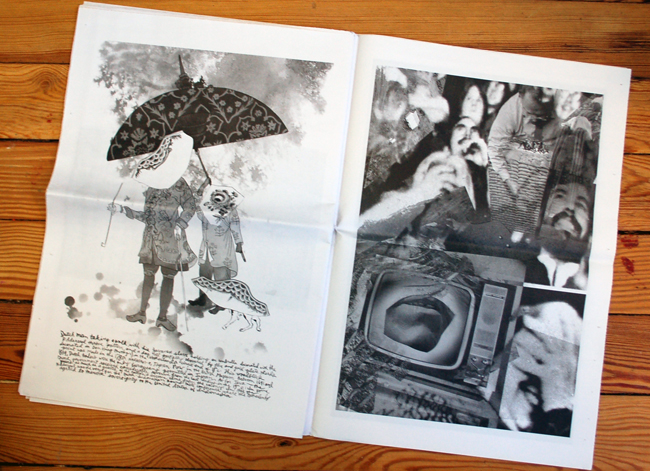 SPACE/LAUNCH (the publication) was edited by artists Ester Partegás (A ’09), Sreshta RitPremnath (A ’09, founder, Shifter Magazine), Birgit Rathsmann (A ’04), Adam Shecter (A ’06), and Roger White (A ’05, co-founder, Paper Monument). A newsprint edition of 500, it will be available for free.
SPACE/LAUNCH features 39 works by the following artists:
SPACE/LAUNCH (the publication) was edited by artists Ester Partegás (A ’09), Sreshta RitPremnath (A ’09, founder, Shifter Magazine), Birgit Rathsmann (A ’04), Adam Shecter (A ’06), and Roger White (A ’05, co-founder, Paper Monument). A newsprint edition of 500, it will be available for free.
SPACE/LAUNCH features 39 works by the following artists:
Lauren Adams, A ’09, Trevor Amery, A ’13, Nicolás Bacal, A ’14, Seline Baumgartner, A ’14, Caitlin Berrigan, A ’08, Willard Boepple, A ’63, Katherine Bradford, F ’09, Gordon Chandler, A ’74, Sue Collier, A ’79, Don Edler, A ’12, Sharona Eliassaf, A ’11, Amy Feldman, A ’09, Ash Ferlito, A ’12, James Benjamin Franklin, A ’94, Daniel Giles, A ’13, Hiroyuki Hamada, A ’98, Shadi Harouni, A ’13, Jason Head, A ’07, John Houck, A ’08, Zerek Kempf, A ’06, Gwenessa Lam, A ’04, Martin Landau, A ’84, Jaeeun Lee, A ’11, Anthony Lepore, A ’04, Holli McEntegart, A ’14, Lavar Munroe, A ’13, Amy Pryor, A ’00, Ronny Quevedo, A ’13, Zizi Raymond, A ’86, Claudia Sbrissa, A ’03, Mike Schuwerk, A ’10, Rudy Shepherd, A ’00, Rachel Stern, A ’14, Ceaphas Stubbs, A ’12, Marc Swanson, A ’00, F ’14, Clare Torina, A ’12, Rodrigo Valenzuela, A ’13, Mary Walling Blackburn, A ’11, Claire Zitzow, A ’11
]]>Group Exhibition at SideCar Gallery
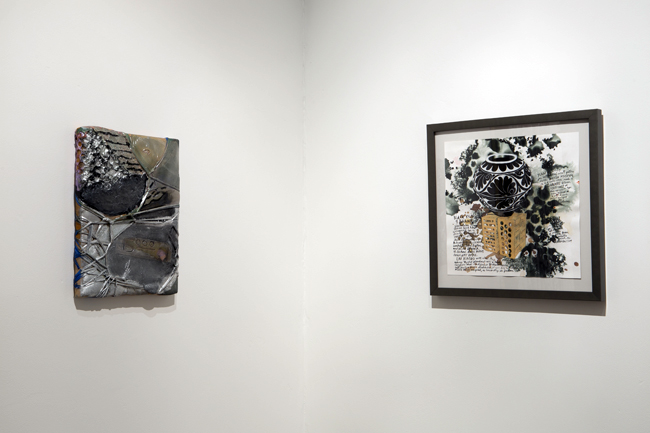 EarthTwerks and other celestial familiars at SideCar Gallery in Hammond, Indiana
November 15 – January 4, 2015
With EARTHTWERKS & Other Celestial Familiars, the collective of visual artists acts as curators, representing visual art trends across the United States and coming together under the conceptual rubric of the notion of heliograph.
Embodying the communicative nature of the heliograph, a historic long-distance optical communication method for surveying and forest protection work, the exhibition at SideCar seeks to position each member’s practice in light of the networked nature of the group, despite the dispersed physical locations of each member. As social and cultural space is shifting with the expansion of online accessibility the option to be portable and fluid becomes an alternative to wholesale relocation.
The artists included in the show are: Lauren Frances Adams (MD), Eleanna Anagnos (NY), Joshua Bienko (TN), Clare Britt (IL), Eric Hibit (NY), Fritz Horstman(CT), Leeza Meksin (NY), Sheilah Wilson (OH), Zahar Vaks (NY), Christine Wong Yap (NY).
SideCar Gallery can be found online at: http://gallerysidecar.com. The gallery is located at 411 Huehn Street, Hammond, Indiana, 46327.]]>
EarthTwerks and other celestial familiars at SideCar Gallery in Hammond, Indiana
November 15 – January 4, 2015
With EARTHTWERKS & Other Celestial Familiars, the collective of visual artists acts as curators, representing visual art trends across the United States and coming together under the conceptual rubric of the notion of heliograph.
Embodying the communicative nature of the heliograph, a historic long-distance optical communication method for surveying and forest protection work, the exhibition at SideCar seeks to position each member’s practice in light of the networked nature of the group, despite the dispersed physical locations of each member. As social and cultural space is shifting with the expansion of online accessibility the option to be portable and fluid becomes an alternative to wholesale relocation.
The artists included in the show are: Lauren Frances Adams (MD), Eleanna Anagnos (NY), Joshua Bienko (TN), Clare Britt (IL), Eric Hibit (NY), Fritz Horstman(CT), Leeza Meksin (NY), Sheilah Wilson (OH), Zahar Vaks (NY), Christine Wong Yap (NY).
SideCar Gallery can be found online at: http://gallerysidecar.com. The gallery is located at 411 Huehn Street, Hammond, Indiana, 46327.]]>
Two-Person Exhibit at University of North Georgia
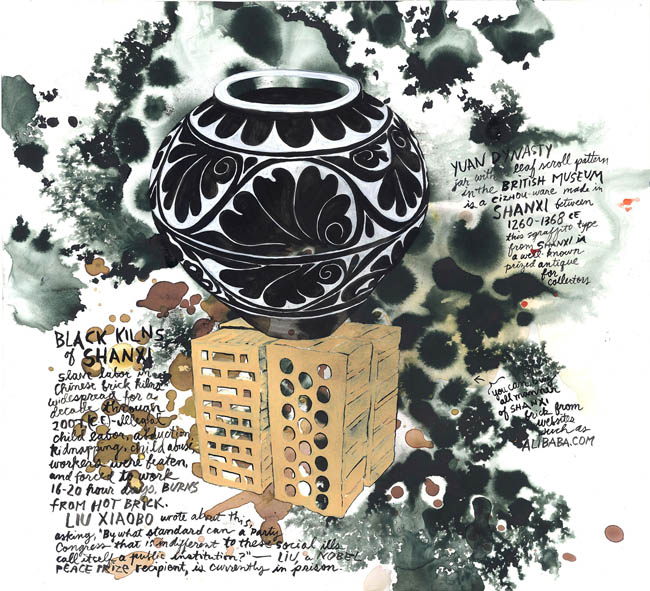 Belongings Once Were, curated by Beth Sale at The University of North Georgia, September 22 – October 17, 2014
A two-person show featuring the works of Lauren F. Adams and Jasey Jones.
“In her own words, artist Lauren Adams represents through her paintings situations that “take to task American consumerism”. Similarly, artist Jasey Jones layers images such as vintage advertising and contemporary packaging barcodes to create inescapable references to consumerism. Thorstein Veblen, noted nineteenth-century sociologist and economist, invented the term “conspicuous consumption” to refer to the practice of spending money on luxury goods as statements of economic power. Through their works in the exhibition, Belongings Once Were, Adams and Jones invite their viewers to consider the definitions and aesthetics of luxury vs. need through time, and the price of acquisition and who may have paid it. Most striking in the work of each artist is the frequent juxtaposition of famous paintings or delicate porcelain, objects synonymous with wealth and luxury, with sobering images of slave ships or receipts for the sale of children. Through layers of paint, paper, and porcelain, the artists also layer contrasting definitions of art, product, and the price of wealth. The noted art historian, Leo Steinberg, once famously remarked that all art is about art in a ground- breaking article of the same title. In Belongings Once Were the viewer will recognize iconic artworks such as Gaugin’s French Polynesia, the Palace at Versaille, or English Garden porcelain. The artists, however, invite the viewer to look beyond the familiar images. In Decorum #10, Adams directs the viewer to consider the life of a Polynesian woman pre-European contact prior to her marketing and objectification. Similarly, Decorum #7 invites one to consider the once rare and elegant pastime of taking tea against a representation of the tiles of the courtyard of Versaille, which were laid with backbreaking labor. In a clever and thought-provoking play on words, Decorum #20 depicts luxurious Toile fabric by Brunschwig & Fils overlaid by silhouettes of slaves who helped make the creation of such fabrics possible: toil begets Toile.”
Belongings Once Were, curated by Beth Sale at The University of North Georgia, September 22 – October 17, 2014
A two-person show featuring the works of Lauren F. Adams and Jasey Jones.
“In her own words, artist Lauren Adams represents through her paintings situations that “take to task American consumerism”. Similarly, artist Jasey Jones layers images such as vintage advertising and contemporary packaging barcodes to create inescapable references to consumerism. Thorstein Veblen, noted nineteenth-century sociologist and economist, invented the term “conspicuous consumption” to refer to the practice of spending money on luxury goods as statements of economic power. Through their works in the exhibition, Belongings Once Were, Adams and Jones invite their viewers to consider the definitions and aesthetics of luxury vs. need through time, and the price of acquisition and who may have paid it. Most striking in the work of each artist is the frequent juxtaposition of famous paintings or delicate porcelain, objects synonymous with wealth and luxury, with sobering images of slave ships or receipts for the sale of children. Through layers of paint, paper, and porcelain, the artists also layer contrasting definitions of art, product, and the price of wealth. The noted art historian, Leo Steinberg, once famously remarked that all art is about art in a ground- breaking article of the same title. In Belongings Once Were the viewer will recognize iconic artworks such as Gaugin’s French Polynesia, the Palace at Versaille, or English Garden porcelain. The artists, however, invite the viewer to look beyond the familiar images. In Decorum #10, Adams directs the viewer to consider the life of a Polynesian woman pre-European contact prior to her marketing and objectification. Similarly, Decorum #7 invites one to consider the once rare and elegant pastime of taking tea against a representation of the tiles of the courtyard of Versaille, which were laid with backbreaking labor. In a clever and thought-provoking play on words, Decorum #20 depicts luxurious Toile fabric by Brunschwig & Fils overlaid by silhouettes of slaves who helped make the creation of such fabrics possible: toil begets Toile.”
Above text by Deborah Prosser, Ph.D.
]]>'American Catastrophe Report' at American University, Washington, D.C.
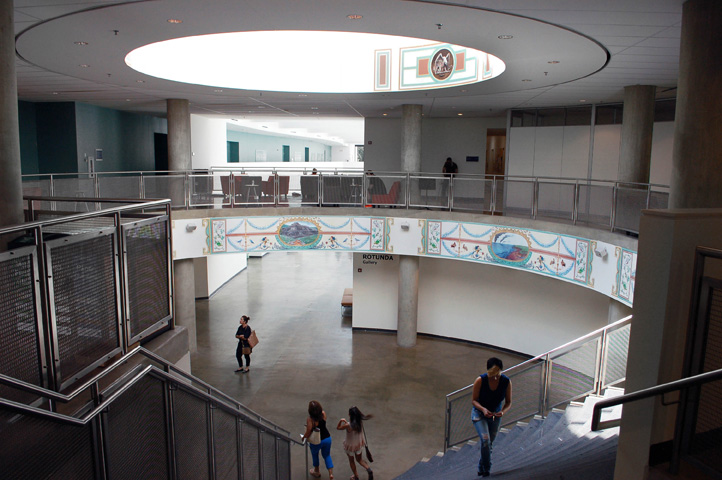 American Catastrophe Report on view at American University Katzen Arts Center August 2014 – August 2015.
For more information: http://www.american.edu/cas/katzen/calendar/?id=5706594
American Catastrophe Report on view at American University Katzen Arts Center August 2014 – August 2015.
For more information: http://www.american.edu/cas/katzen/calendar/?id=5706594
Artist Lauren Frances Adams has created American Catastrophe Report, an installation that acts as both homage and critique of the decorative frescoes in the United States Capitol Building, originally painted in the 19th c. by Italian-born artist Constantino Brumidi. The site-specific artwork by Adams is installed in American University’s Katzen Arts Center, in both the upper and lower rotunda in the center of the building, less than six miles from where Brumidi’s paintings are located. The prints forming American Catastrophe Report have the appearance of paintings due to the unique process Adams uses, where hand-painted originals are digitally scanned then printed for long-term public display. Adams updates Brumidi’s Capitol ornamentation by directly addressing ecological disasters in America that have been caused by human activities.
Visitors to the Katzen Arts Center will see an installation that is a mix of appropriated and invented imagery. Adams adapts Brumidi’s original frescoes in the U.S. Senate Wing that picture landscapes of the sparsely populated western states of the mid-19th century, as well as a variety of detailed images of birds. According to historians, Brumidi copied from lithographs in the Pacific Railroad Report and the Mexican Boundary Report, published in the 1850’s. It is possible that Brumidi’s incorporation of these landscapes were intended to not only celebrate scenic visions of America but also to promote a comprehensive identity of American geography and inevitable settlement. Further promoting specificity of place, the birds pictured in the Senate wing point to the importance of uniquely American subject matter in Brumidi’s efforts. Assistant curator for the Office of Senate Curator, Amy Elizabeth Burton, writes about the time capsule nature of the paintings, stating in the catalogue (published in 2014) To Make Beautiful the Capitol: Rediscovering the Art of Constantino Brumidi, “Brumidi’s birds reflect the 19-century surge in westward expansion and federal support for exploration and scientific discovery across the young and developing nation.”
Extending and celebrating this act of copying, Lauren Frances Adams has updated Brumidi’s masterful efforts with similar forms — landscapes and ornithological themes — but with a decidedly different artistic outcome. Reflecting a century and a half of human enterprise since Brumidi’s time, a selection of landscapes in decorative cartouches offers up these situations: Fracking (in rural Pennsylvania), the Great Pacific Garbage Patch, Mountaintop Removal Mining (in West Virginia), the Deepwater Horizon Oil Spill (in the Gulf of Mexico), and Climate Change (specified as glacial retreat in Alaska). Corresponding to each man-made ecological disaster, and pointing towards the totalizing effects of habitat destruction, pollution via chemicals and garbage, and changes in weather conditions, Adams has included several birds that represent the threats to fauna as environmental destruction advances: Scarlet Tanager, Bristle-Thighed Curlew, Cerulean Warbler, Brown Pelican, and the Tufted Puffin.
Other imagery present throughout the rotunda gives depth to the historical relationships between American citizens and our physical landscape. Acting as symbolic prescience, ornamental designs incorporate two birds distinctly absent from America today: the Carolina Parakeet and the Passenger Pigeon, both extinct. Decorative flora in the paintings incorporates kudzu, a non-native species that has caused widespread ecological damage in the United States. Lofted high above, two medallions face one another in the upper rotunda: a war-like eagle and a gentle lamb. Utilizing the neoclassical aesthetic employed by Constantino Brumidi (who was in turn inspired by ornamental Renaissance paintings in the Vatican), Adams incorporates uniquely American identifications, inviting visitors to the American University Katzen Arts Center to reflect upon the conundrum of the contemporary American condition visualized in American Catastrophe Report.
About the artist: Lauren Frances Adams mines the histories of power, labor, and visual culture to make surprising connections that resonate with current sociopolitical issues. She is a 2007 MFA graduate of Carnegie Mellon University, and lives and works in Baltimore, Maryland, where she is a full-time faculty member in painting at the Maryland Institute College of Art. She has had recent solo exhibitions at Back Lane West, Cornwall, UK; Contemporary Art Museum St. Louis; EXPO Chicago; Conner Contemporary, Washington, D.C. and Royal NoneSuch Gallery, Oakland, California. Her work has been featured in group exhibitions including: The Walters Art Museum (as a finalist for the Sondheim Prize) in Baltimore, MD; Nymans House and Gardens, Sussex, UK; CUE Foundation, New York; Mattress Factory, Pittsburgh, PA; and the Andy Warhol Museum, Pittsburgh, PA; among many others. She has been awarded Cité Internationale des Arts in Paris residency, Skowhegan School of Painting and Sculpture residency, and she is a Joan Mitchell Foundation MFA Grant recipient. Adams is the co-founder of Ortega y Gasset Projects, a gallery and long-distance artist collective in Bushwick/Ridgewood neighborhood in Queens. For more information, visit her website at http://www.lfadams.com.
For further press inquiries, contact the artist directly: laurenfrancesadams@gmail.com
The artist would like to thank the faculty and staff at American University who made the installation possible, including: Professor Zoë Charlton, Professor Tim Doud, Facilities Manager Jason Lurie, Installation team Bonner Sale and Zac Willis, the print center technicians at MICA, and especially The Clark Hulings Fund.
]]>'Precarious Prototypes' and 'Decorum' at The Walters Art Museum
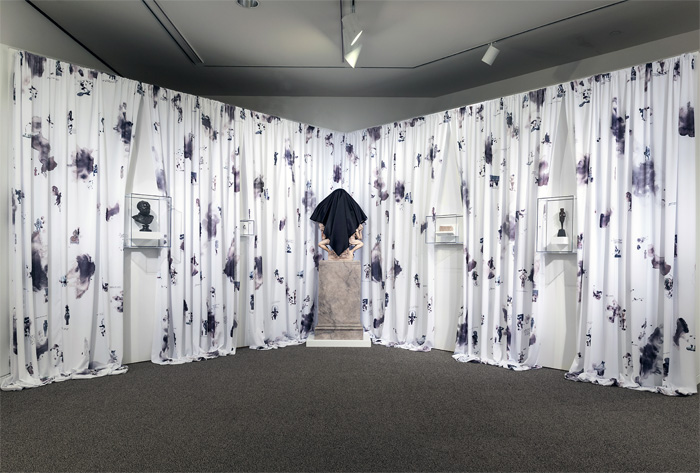 Precarious Prototypes on view at the Walters Art Museum in Baltimore, Maryland, June – August 2014.
Precarious Prototypes on view at the Walters Art Museum in Baltimore, Maryland, June – August 2014.
At the core of my work are critical explorations of labor and class in visual culture. I draw heavily upon the historical decorative arts to find contradictions within the contexts they originated. In my work, objects such as wallpaper patterns, ceramics, and paintings do not simply reflect the mood of a given culture but are also tools for critique.
Alongside painting and mixed-media installations, I use domestic materials in my research on the construction of political identityThese ubiquitous yet formative objects are of great interest to me—particularly repetitive decorative patterns. In these patterns, I alter and manipulate both the images they depict and the notions of authoritative taste they promote.
My installation here is composed of two related bodies of work: Decorum, an ongoing series of paintings that attempt to trace global histories of enslaved peoples from antiquity to the present, and Precarious Prototypes, a textile installation that responds to and transforms selected objects from the Walters Art Museum’s collection. In this installation of Decorum, the museum becomes a venue for an open-ended but limited investigation of slavery. In considering the relationship between ornament and oppression, my inquiry comprises appropriation and historic archival research. In Precarious Prototypes, the museum’s own collection has been used to focus on the mannered representation of enslaved peoples and other figures-in-service throughout the history of art and to consider its place in museums and popular culture.
I began this project (Precarious Prototypes) in search of objects in The Walters Museum collection that depicted enslaved peoples. Expanding my inquiry into the museum as labor archive, Precarious Prototypes ultimately explores the mannered representations of servitude and objectification within the museum’s collection. Select objects are exhibited as well as printed, to understand and unsettle the role of the museum as master narrator. And so, the drapery both reveals and conceals, becoming an index of unstable contradictions. Specifically, I am looking at how depictions of the body as subservient, contorted, dehumanized, grotesque and lacking agency, unravel how art history becomes art as history.
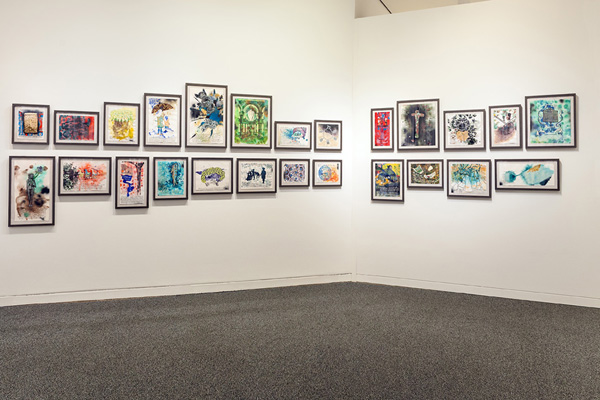 Above, installation view of Decorum
Above, installation view of Decorum
Decorum is an incomplete but growing index of the histories of enslaved people as evinced in historical records. Allusions to slavery in the paintings are juxtaposed with decorative and textual sources in order to trace the complex structures that surround labor and power inequalities. Decorum considers the problems of sufficiently representing the legacy of slavery. Archival remnants of slave narratives, ornament, and my own personal inquiries constitute an open-ended process of asking how might the decorative arts participate, either actively or silently, in promoting or reflecting dominant ideologies of social hierarchy, political authority, and cultural fantasy.
Part of the Sondheim Prize Exhibition at the Walters Art Museum, juried by Claire Gilman, Sarah Oppenheimer and Olivia Shao.
Fore more information, visit The Walters website.
Press reviews: The Baltimore City Paper The Baltimore Sun BmoreArt Art Fag City
]]>
Sondheim Finalists Exhibition at the Walters Museum
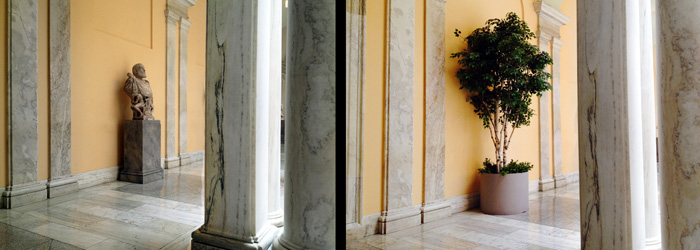 I have been selected as a finalist for the Janet and Walter Sondheim Artscape Prize. My work will be on view at The Walters Art Museum from Saturday, June 21, 2014, through Sunday, August 17, 2014.
Presented by the Walters and the Baltimore Office of Promotion and the Arts, this exhibition will show the work of the finalists for the 2014 Janet & Walter Sondheim Artscape Prize. Artists will compete for top honors and a $25,000 fellowship in the Greater Baltimore area’s most prestigious arts competition. The prize assists in furthering the career of a visual artist or visual artist collaborators living and working in this region. Held in conjunction with Artscape, America’s largest free arts festival, the semifinalist and finalist exhibitions will be presented in partnership with the Walters and the Maryland Institute College of Art. The competition winner will be announced at the awards ceremony at the Walters on July 12. Artscape will be July 18–20, 2014.
The other finalists are Kyle Bauer, Shannon Collis, Marley Dawson, Neil Feather, Kyle Tata, and Stewart Watson.
Read more on the Artscape website and at the Walters Museum website.]]>
I have been selected as a finalist for the Janet and Walter Sondheim Artscape Prize. My work will be on view at The Walters Art Museum from Saturday, June 21, 2014, through Sunday, August 17, 2014.
Presented by the Walters and the Baltimore Office of Promotion and the Arts, this exhibition will show the work of the finalists for the 2014 Janet & Walter Sondheim Artscape Prize. Artists will compete for top honors and a $25,000 fellowship in the Greater Baltimore area’s most prestigious arts competition. The prize assists in furthering the career of a visual artist or visual artist collaborators living and working in this region. Held in conjunction with Artscape, America’s largest free arts festival, the semifinalist and finalist exhibitions will be presented in partnership with the Walters and the Maryland Institute College of Art. The competition winner will be announced at the awards ceremony at the Walters on July 12. Artscape will be July 18–20, 2014.
The other finalists are Kyle Bauer, Shannon Collis, Marley Dawson, Neil Feather, Kyle Tata, and Stewart Watson.
Read more on the Artscape website and at the Walters Museum website.]]>